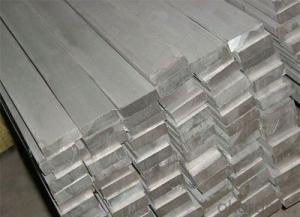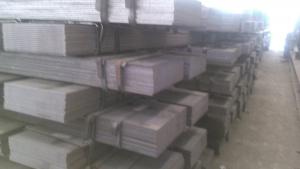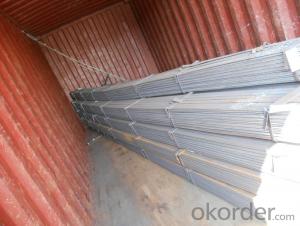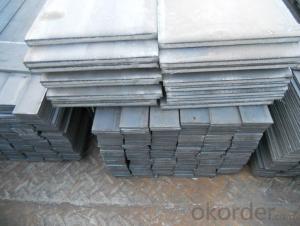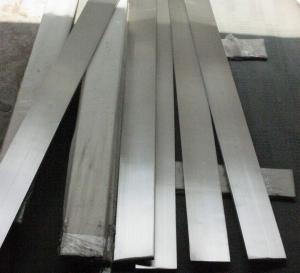Steel Flat Bar Hot Roll 5160 Medium Carbon Round Edge Spring
- Loading Port:
- Tianjin
- Payment Terms:
- TT or LC
- Min Order Qty:
- 24 m.t.
- Supply Capability:
- 25000 m.t./month
OKorder Service Pledge
OKorder Financial Service
You Might Also Like
Product Description:
OKorder is offering Steel Flat Bar Hot Roll 5160 Medium Carbon Round Edge Spring at great prices with worldwide shipping. Our supplier is a world-class manufacturer of steel, with our products utilized the world over. OKorder annually supplies products to European, North American and Asian markets. We provide quotations within 24 hours of receiving an inquiry and guarantee competitive prices.
Product Applications:
Steel Flat Bar Hot Roll 5160 Medium Carbon Round Edge Spring are ideal for structural applications and are widely used in the construction of buildings and bridges, and the manufacturing, petrochemical, and transportation industries.
Product Advantages:
OKorder's Steel Flat Bar Hot Roll 5160 Medium Carbon Round Edge Spring are durable, strong, and resist corrosion.
Main Product Features:
· Premium quality
· Prompt delivery & seaworthy packing (30 days after receiving deposit)
· Corrosion resistance
· Can be recycled and reused
· Mill test certification
· Professional Service
· Competitive pricing
Product Specifications:
Production Manufacturer | DAQIANG |
Product Name | Spring Steel Flat Bar |
Steel Type | Spring Steel |
Material | 5160 |
Others Available Material | 60Si2Mn, 5160H, SUP9, SUP9A, 55Cr3 etc. |
Thickness Range (mm) | 6-50 |
Width Range (mm) | 40-135 |
Usual length (mm) | 5800 |
Daily Capacity (Metric Ton) | 1000 |
Certificate | ISO9001: 2008 |
Edge | Round Edge / Right Angle |
Surface | None / Oil Protection |
Usage | Leaf Springs, Cultivator Blades, Garden Tools, Knifes etc. |
Samples | Free of Charge |
Chemical Composition (Common Material) | |||||||
C | Si | Mn | P | S | Cr | Cu | |
60Si2Mn | 0.56-0.64 | 1.5-2.0 | 0.7-1.0 | ≤0.035 | ≤0.035 | ≤0.35 | |
5160 | 0.56-0.64 | 0.15-0.35 | 0.75-1.0 | ≤0.035 | ≤0.04 | 0.7-0.9 | |
5160H | 0.55-0.65 | 0.15-0.35 | 0.65-1.1 | 0.6-1.0 | |||
SUP9 | 0.52-0.6 | 0.15-0.35 | 0.65-0.95 | ≤0.03 | ≤0.03 | 0.65-0.95 | ≤0.3 |
SUP9A | 0.56-0.64 | 0.15-0.35 | 0.7-1.0 | ≤0.03 | ≤0.03 | 0.7-1.0 | ≤0.3 |
55Cr3 | 0.52-0.59 | ≤0.4 | 0.7-1.0 | ≤0.025 | ≤0.025 | 0.7-1.0 | |
FAQ:
Q1: Why buy Materials & Equipment from OKorder.com?
A1: All products offered byOKorder.com are carefully selected from China's most reliable manufacturing enterprises. Through its ISO certifications, OKorder.com adheres to the highest standards and a commitment to supply chain safety and customer satisfaction.
Q2: How do we guarantee the quality of our products?
A2: We have established an advanced quality management system which conducts strict quality tests at every step, from raw materials to the final product. At the same time, we provide extensive follow-up service assurances as required.
Q3: How soon can we receive the product after purchase?
A3: Within three days of placing an order, we will begin production. The specific shipping date is dependent upon international and government factors, but is typically 7 to 10 workdays.

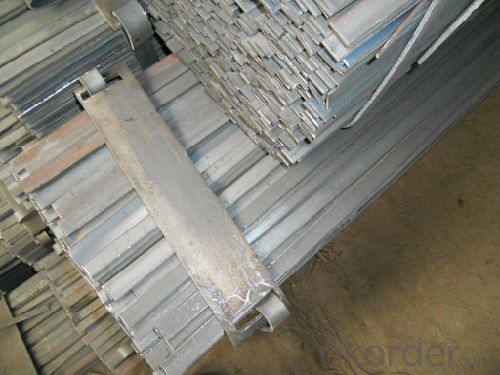
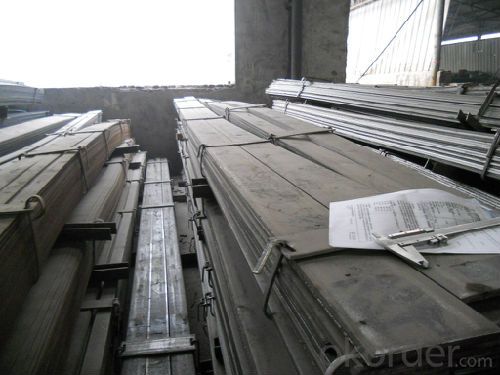
- Q:What are the different cutting methods for steel flat bars?
- There are several cutting methods for steel flat bars, including sawing, shearing, and plasma cutting. Sawing involves using a saw blade to cut through the bar, while shearing uses a shearing machine to trim the material. Plasma cutting, on the other hand, involves using a high-temperature plasma torch to melt and separate the steel. Each method has its own advantages and is suitable for different applications and requirements.
- Q:The grounding electrode 50 angle steel and the ground wire 50, the flat steel lap welding, according to the specification 169 needs the flat steel to be late 90 degrees, bends close to the angle steel side, the overlap width is 4 times (200mm)?
- GB50169-2006 in the 3.4.2 stipulates that the grounding body (line) shall be welded by lap welding, and its lap length shall comply with the following requirements:1. flat steel is 2 times its width (and welded with at least 3 edges);2. round steel is 6 times its diameter;3. round steel and flat steel connection, its length is round steel diameter of 6 times;
- Q:How do steel flat bars behave under high temperatures?
- The behavior of steel flat bars varies depending on the type of steel and the temperature range. Steel, in general, has a high melting point and is known for its heat resistance. However, when subjected to extremely high temperatures, steel flat bars may undergo changes in their properties. At temperatures below the melting point of the steel, the flat bars generally maintain their shape and strength. They may experience slight expansion due to thermal expansion, but this is typically minimal and does not significantly impact their structural integrity. Steel is recognized for its excellent thermal conductivity, which enables it to dissipate heat from hot areas, reducing the risk of deformation or failure. As the temperature continues to rise, steel can gradually lose strength and become more malleable. This process, referred to as tempering, occurs as a result of the rearrangement of the crystal structure of the steel. It is important to note that the specific temperature at which tempering occurs depends on the type of steel. For example, low carbon steels soften at lower temperatures compared to high carbon steels. If the temperature reaches a critical point called the austenitizing temperature, the steel undergoes a phase transformation and becomes austenitic. At this stage, the steel becomes highly malleable and easily shaped. However, it also loses strength and hardness, making it more susceptible to deformation and failure. Moreover, extended exposure to high temperatures can cause steel flat bars to oxidize, leading to the formation of rust. This further weakens the steel and compromises its structural integrity. In summary, steel flat bars generally perform well under high temperatures up to their melting point, maintaining their shape and strength with minimal expansion. However, beyond certain temperature thresholds, steel can soften or undergo phase transformations, resulting in reduced strength and increased vulnerability to deformation. Therefore, it is crucial to consider the specific type of steel and its temperature limitations when exposed to high temperatures.
- Q:Are steel flat bars resistant to heat?
- The resistance to heat in steel flat bars is typically good. The level of resistance depends on the specific type of steel and its composition. To measure heat resistance, one often examines a material's ability to maintain its strength and structural integrity at higher temperatures. Steel is renowned for its high melting point, which reduces the likelihood of deformation or structural failure when exposed to heat. However, it is important to acknowledge that extreme temperatures, like those found in furnaces or through prolonged exposure to high heat, can still cause some thermal expansion or weakening of the steel. Hence, when assessing the appropriateness of steel flat bars for a heat-related purpose, it is crucial to consider the specific application and potential temperature extremes.
- Q:Can steel flat bars be used for making brackets or brackets?
- Yes, steel flat bars can be used for making brackets or brackets. Steel flat bars provide strength, durability, and stability, making them suitable for various structural applications, including brackets.
- Q:Are steel flat bars suitable for agricultural equipment?
- Yes, steel flat bars are suitable for agricultural equipment. Steel is known for its strength and durability, making it an ideal material for heavy-duty applications such as agricultural equipment. Flat bars, in particular, provide a flat and wide surface area that can be easily welded or bolted onto machinery, allowing for secure and stable connections. Additionally, steel flat bars are resistant to corrosion and can withstand harsh weather conditions, making them well-suited for outdoor agricultural environments. The versatility of steel flat bars also allows for customization and adaptation to different equipment needs. Overall, steel flat bars are a reliable and widely used choice for agricultural equipment due to their strength, durability, and resistance to wear and tear.
- Q:What is the difference between carbon steel and stainless steel flat bars?
- When comparing carbon steel and stainless steel flat bars, their composition and properties are the main distinguishing factors. Carbon steel flat bars consist primarily of iron and carbon, with a maximum carbon content of 2.1%, resulting in strength and durability but lacking corrosion resistance. Conversely, stainless steel flat bars possess a significant amount of chromium (at least 10.5%), in addition to iron and other elements. This chromium content forms a protective layer on the steel's surface, rendering it highly resistant to corrosion and rust. Stainless steel flat bars are commonly utilized in applications where exposure to moisture or chemicals is a concern, such as marine environments or the food industry, owing to their corrosion resistance. Conversely, carbon steel flat bars find frequent use in applications that prioritize strength and durability, such as construction and manufacturing. Another notable distinction lies in their appearance. Carbon steel flat bars exhibit a dull gray finish, while stainless steel flat bars possess a shiny, reflective surface. This aesthetic difference may be a significant consideration in certain applications where appearance matters, such as architectural or decorative purposes. In conclusion, the key disparities between carbon steel and stainless steel flat bars pertain to their corrosion resistance, composition, and appearance. Carbon steel is robust and durable but susceptible to corrosion, whereas stainless steel boasts high corrosion resistance and a shiny finish. The choice between the two depends on the specific requirements of the given application.
- Q:What are the safety considerations when working with steel flat bars?
- When working with steel flat bars, important safety considerations include wearing appropriate personal protective equipment (PPE) such as gloves, safety glasses, and steel-toed boots to protect against potential injuries from sharp edges or falling bars. It is crucial to ensure that the work area is well-ventilated and free from any flammable materials as sparks generated during cutting or welding processes can pose fire hazards. Additionally, proper handling techniques should be followed to avoid strains or injuries, and using appropriate tools and equipment, such as clamps or vices, can help stabilize the bars and minimize the risk of accidents.
- Q:Can steel flat bars be used for making frames or supports for solar panels?
- Steel flat bars are suitable for the construction of frames or supports for solar panels. This is because steel is a robust and long-lasting material that offers exceptional structural support. Its high strength-to-weight ratio makes it popular in construction and engineering projects. The fabrication and welding of steel flat bars are straightforward, allowing for the creation of custom frames or supports for solar panels. Furthermore, steel is resistant to corrosion, making it ideal for outdoor installations exposed to diverse weather conditions. In conclusion, steel flat bars guarantee stability and longevity when used for constructing frames or supports for solar panels.
- Q:What is a steel flat bar?
- Made of steel, a steel flat bar is a metal bar that is long and rectangular in shape. It is commonly used in construction, manufacturing, and engineering. Due to its flat surface, it can be easily fabricated and installed in different projects. Steel flat bars have various applications such as structural supports, braces, frames, and reinforcement in concrete structures. They come in different sizes, thicknesses, and lengths to meet specific needs. Known for their strength, durability, and resistance to corrosion, steel flat bars are widely favored in numerous industries.
1. Manufacturer Overview |
|
|---|---|
| Location | |
| Year Established | |
| Annual Output Value | |
| Main Markets | |
| Company Certifications | |
2. Manufacturer Certificates |
|
|---|---|
| a) Certification Name | |
| Range | |
| Reference | |
| Validity Period | |
3. Manufacturer Capability |
|
|---|---|
| a)Trade Capacity | |
| Nearest Port | |
| Export Percentage | |
| No.of Employees in Trade Department | |
| Language Spoken: | |
| b)Factory Information | |
| Factory Size: | |
| No. of Production Lines | |
| Contract Manufacturing | |
| Product Price Range | |
Send your message to us
Steel Flat Bar Hot Roll 5160 Medium Carbon Round Edge Spring
- Loading Port:
- Tianjin
- Payment Terms:
- TT or LC
- Min Order Qty:
- 24 m.t.
- Supply Capability:
- 25000 m.t./month
OKorder Service Pledge
OKorder Financial Service
Similar products
New products
Hot products
Related keywords
